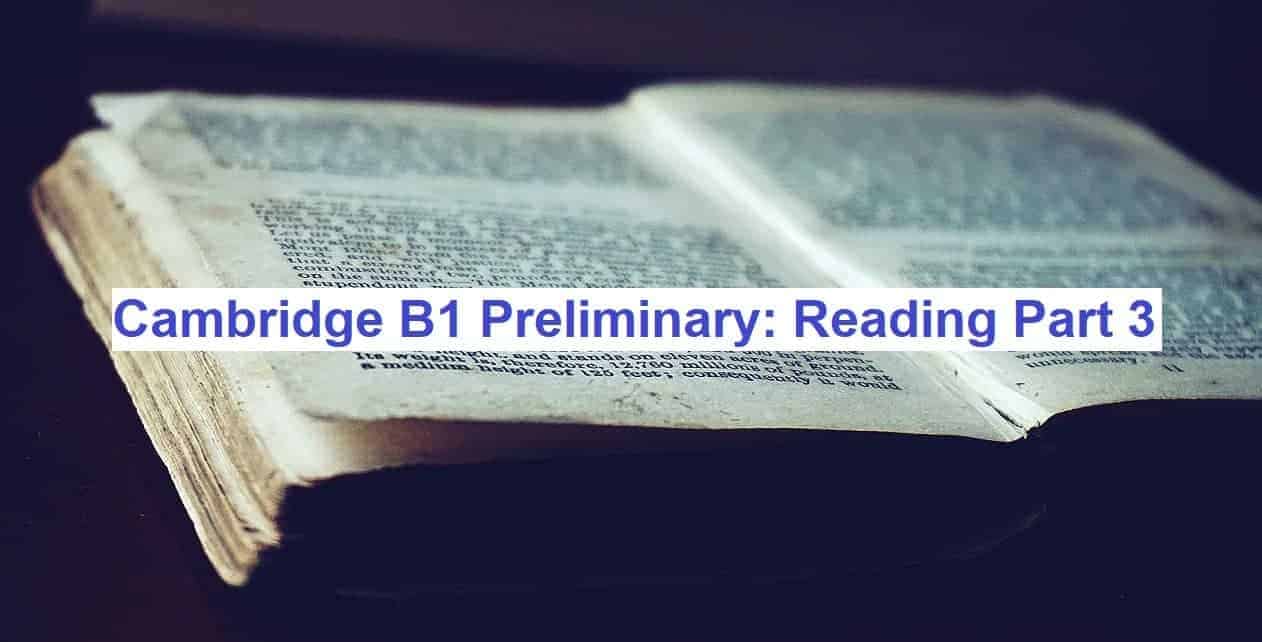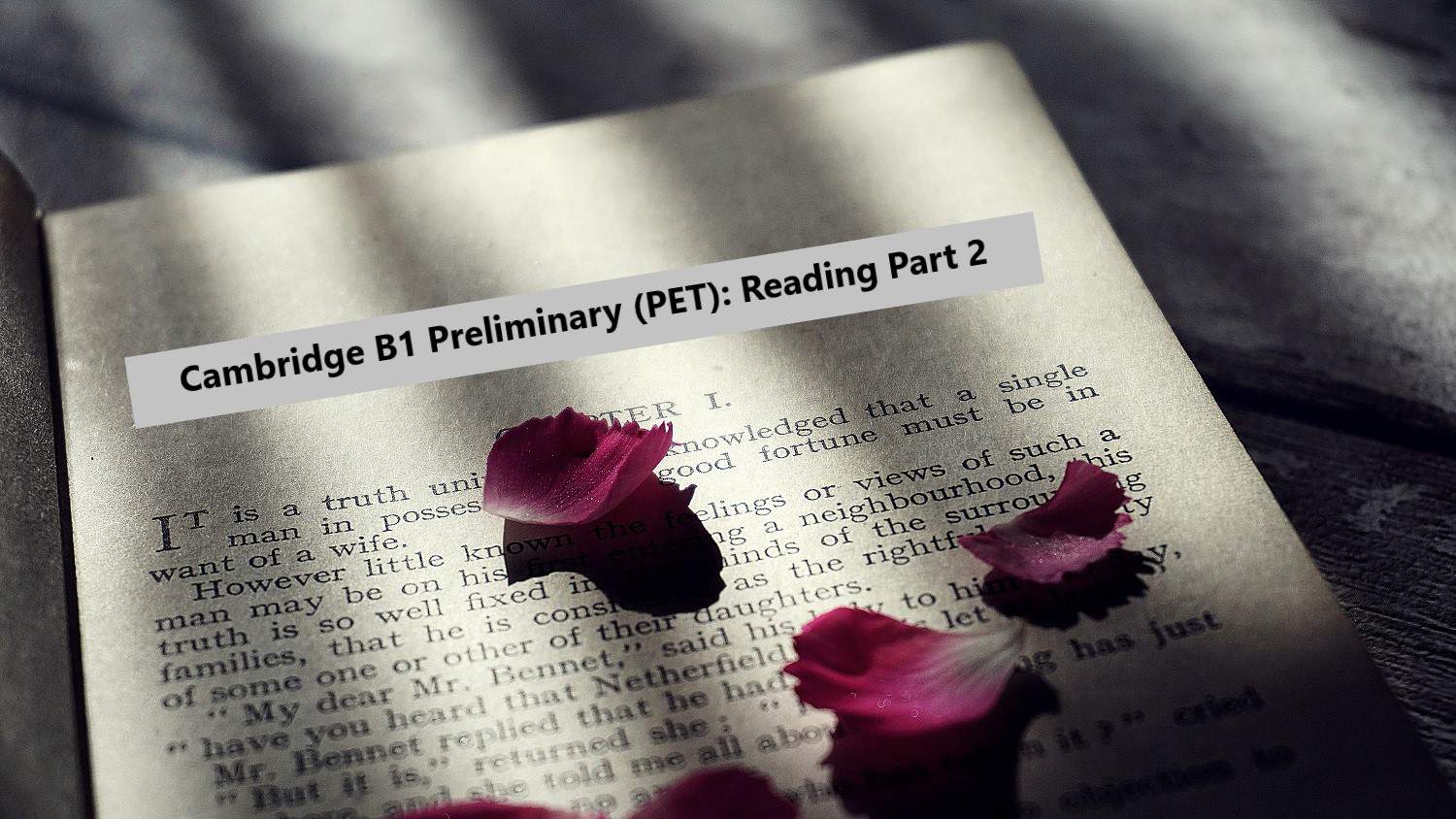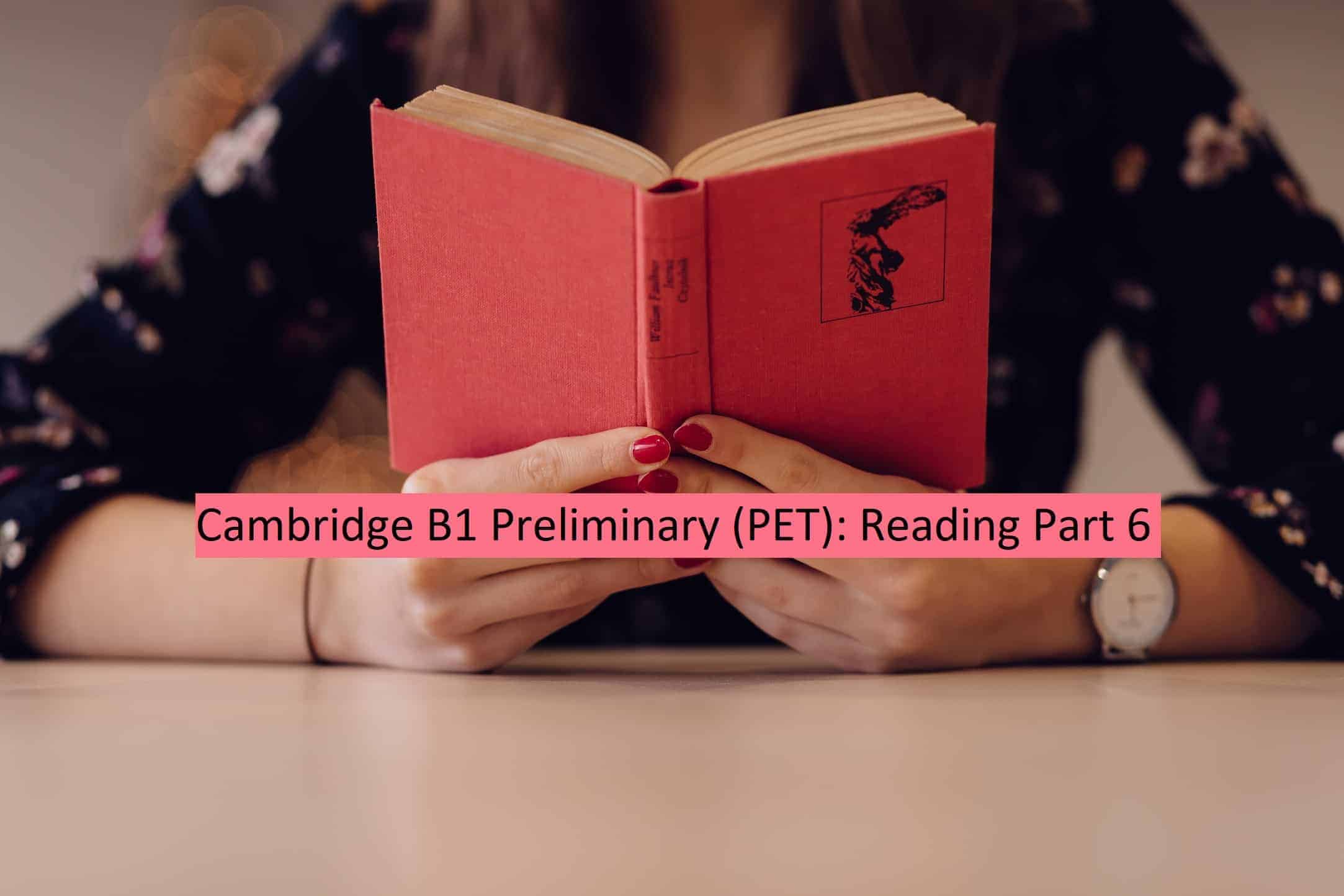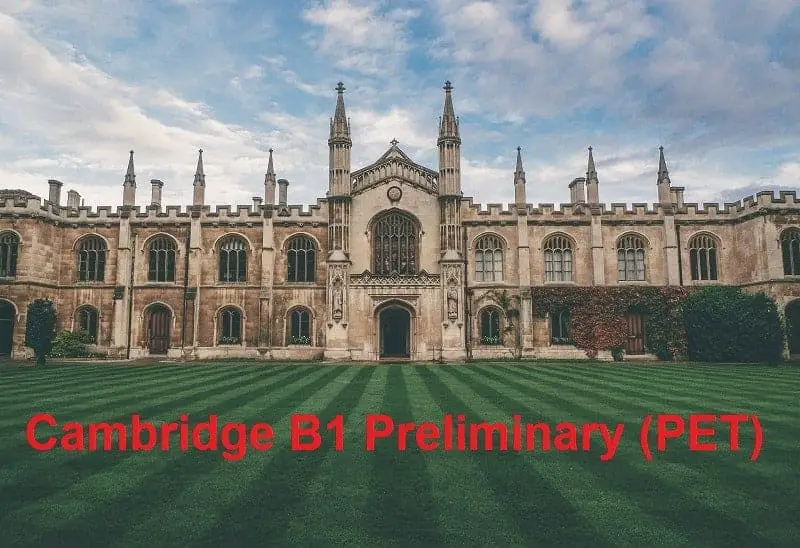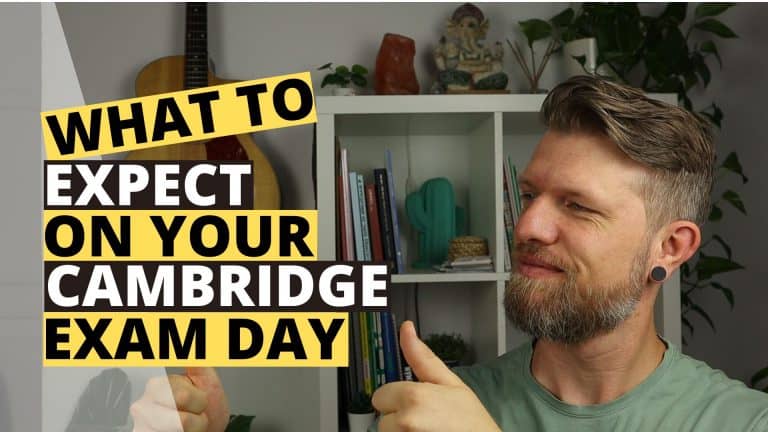Reading Part 3
This article is right for you if you are looking for very specific information about Reading Part 3 of the Cambridge PET exam. I’m going to show you what the task looks like, common problems and some useful tips and strategies to make it easier for you to be successful and get great marks.
If you are interested in more general information, I recommend my article on everything you need to know about PET. There, you will find out more about the whole exam and it’s a good start if you are new to B1 Preliminary.
What do you have to do in Part 3?
4-option multiple choice – In Part 3 of the PET Reading paper you read a longer text (see the example below) and answer five question. For each of those questions you choose from four options A, B, C or D.
Part 3 tests your general and detailed understanding of a longer text as well as your understanding of the writer’s opinions and attitude. It is a true reading task compared to Parts 5 and 6 which test your grammar and vocabulary.

The text in Part 3 is always a little bit longer with between 300-350 words. In addition, you get five questions with four possible answers A-D.
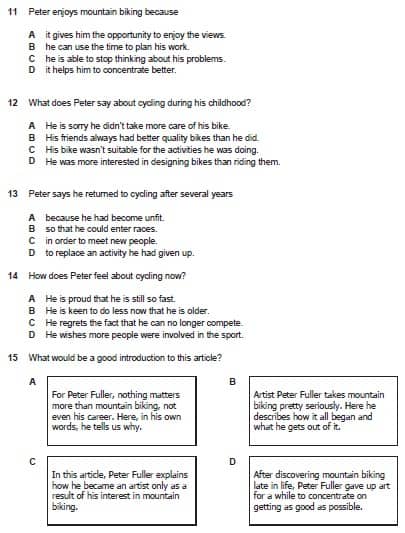
You can see that the last question looks a different from the others, but I’m going to talk about that a little bit later.
Always remember that you also have to transfer your answers onto a separate answer sheet which you get from the examiner at the beginning of the test.
As you probably know, there are six different parts in the Reading section of the B1 Preliminary exam. Each part has its own difficulties, but there are also a few general things that are interesting for you to know. You can find out more by checking out my article on the PET Reading paper.
What is difficult about Part 3?
As with all the different sections in the B1 Preliminary Reading test there are also some common problems that students experience in Part 3. So first, I’m going to point out the issues and then we’re going to look at some possible solutions.
Don’t get into time trouble
In PET Reading you only get 45 minutes to complete 6 different tasks. Some of these tasks, like Part 3, ask you to read pretty long texts and answer questions or fill in gaps. In addition, you always have to transfer your answers onto an extra answer sheet, which usually takes around five minutes. That leaves us with around 40 minutes to answer all the questions or, more or less, 6 1/2 minutes per task.
Obviously, that is not a lot of time and you need to be very careful. Always have an eye on the clock and make sure that you don’t spend too much time on a single task.
Don’t get distracted
In every Cambridge English exam like B1 Preliminary, B2 First or C1 Advanced you can find that the people who create the questions and write the tasks often try to confuse you. The wrong answers are very similar to the correct one or you can find information connected to all the different possible answers in the same text.
We call these pieces of wrong or confusing information ‘distractors’. You have to practise the different tasks quite a lot to learn the best techniques to deal with these distractors effectively.
Don’t let the last question confuse you
The last question in Reading Part 3 always looks different from the other questions and it is very important that you don’t get confused by that. Believe me, there is really nothing to worry about if you know what exactly you have to do in this last question.
Tips and strategies for Reading Part 3
Now that we’ve had a look at the three most common issues that I usually see with my students who prepare for B1 Preliminary we can also check what the solutions to these problems are, so in this part of my article I’m going to try and give you as much useful information as possible.
Follow a step-by-step process
One of the most crucial things in the exam is that you have a plan for each task so you know exactly what you have to do. This can help you a lot if you are running out of time. Instead of getting really nervous and making unnecessary mistakes you can take a deep breath, focus on your step-by-step process and keep collecting marks.
In Reading Part 3 this process looks like this:
- Read questions 11-14 and underline the key words
- Quickly read the text and highlight the parts where you can find the answers to questions 11-14
- Re-read the highlighted parts and choose the correct answer.
- Read question 15 and the possible answers carefully and underline key words.
- Choose the correct answer for question 15.
Let me now show you what the first three steps might look like for our example from before. After that, we’ll deal with question 15.
Questions 11-14 follow the order of the text
When you look at the first four questions in Reading Part 3 keep in mind that they follow the order of the text, which means that the answer to the first question is somewhere at the beginning of the text and the answer to question 14 more towards the end.
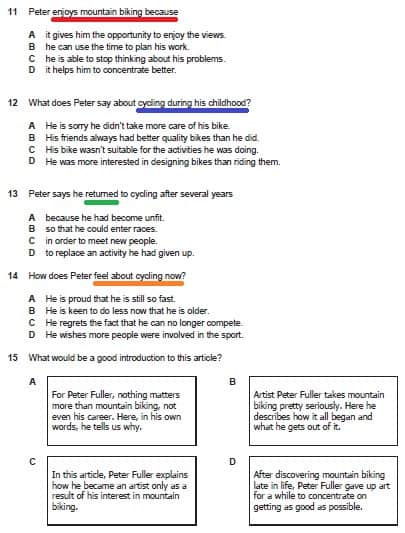
First of all, you want to look at questions 11-14 and underline the most important words. As you can see above, I’ve already done the work for you and now we read the text quickly, just to get a general understanding of the topic and what happens in the text. While you are reading just highlight the parts that match the questions and where you think you can find the correct answers.
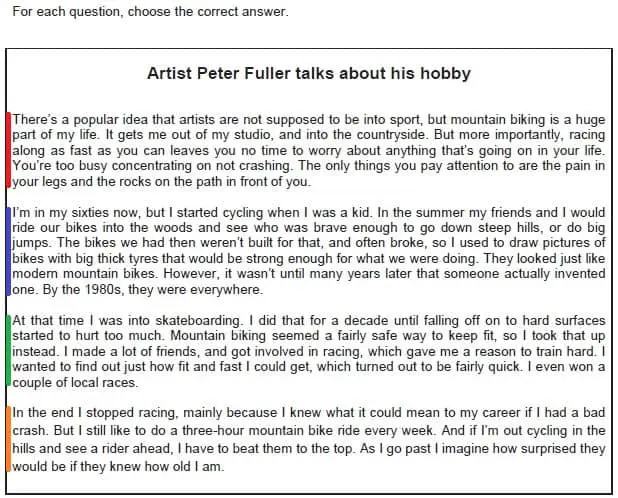
Again, I’ve already highlighted everything for you. The colours show you which part belongs to which of the questions. You can see that, indeed, the questions follow the order of the text.
After you’ve done this little bit of preparation you re-read the different parts more carefully and choose the correct answer for each question.
In our example, it looks like this.
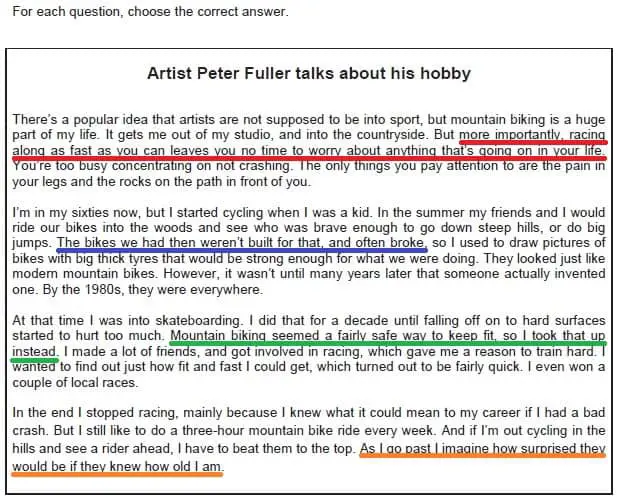
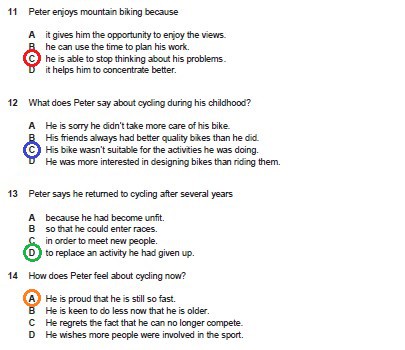
The underlined parts in the text perfectly match the circled options in the questions.
Remember, there are three steps to answering questions 11-14 and it is always the same process. Practise to get faster and there won’t be a problem for you.
How to deal with question 15
Question 15 is a little bit different from the other questions, but if you know how it works, it isn’t really a problem.
As I’ve told you before, all the other questions follow the order of the text and they ask you about some detailed information. Question 15, however, asks you about the whole text. You can’t just look for some detail that gives you the correct answer, but you need to understand the main idea(s) and what the author wants to say.
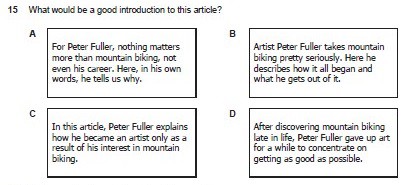
In our example the question asks for a good introduction to the article. This means that you have to understand what the article talks about in order to make that decision.
A good way to answer this task is to eliminate the wrong options. They always include something that the text doesn’t talk about or they give you false information so it is normally quite easy to find the wrong ones.
For example, in option A we see that Peter Fuller never says that mountain biking is more important to him than his career. Option C describes the relationship between mountain biking and Peter’s career as an artist, but in the text he never says that he chose his career only because of the sport. And lust but not least, option D says that he gave up art to become as good as possible, which is simply not correct. In fact, he gave up racing because he was afraid of accidents.
The only possible answer that is left is option B and when we look at the information, we see that it describes the text pretty well. So, don’t be scared of this last question, but be careful because it works a little bit differently from the other tasks in Reading Part 3.
General tips
There are a few things you can do to generally get ready for the Reading paper of the B1 Preliminary exam.
First of all, try to read things in English as often as possible. Even if you only have five or ten minutes every day on the bus to or from work or school, use it practise some reading. Read whatever you want: the news, stories, articles or anything else you enjoy.
You will become a faster reader, which can save you time in the test, and you will see a lot of grammatical structures and new vocabulary that you might see again when you take the exam.
Secondly, think about taking English classes to prepare yourself specifically for the exam. It can be very helpful to have a teacher who can give you feedback on your typical mistakes and things you already do well so you know what you have to improve what you should focus on when getting ready for PET. To find a good school near you have a look at my article about everything you need to know about B1 Preliminary.
Last but not least. think about your time management and the order in which you want to go through the different tasks in the exam. If you want to know more, you can follow the link to my post about the Reading paper in the PET test.
Lots of love,
Teacher Phill 🙂

